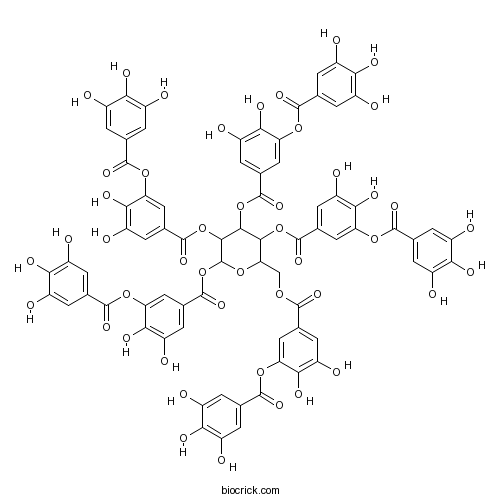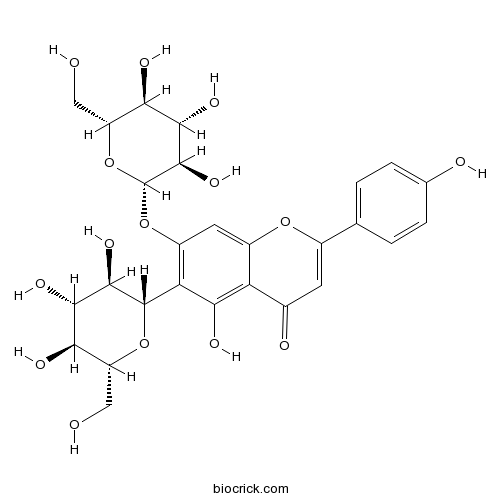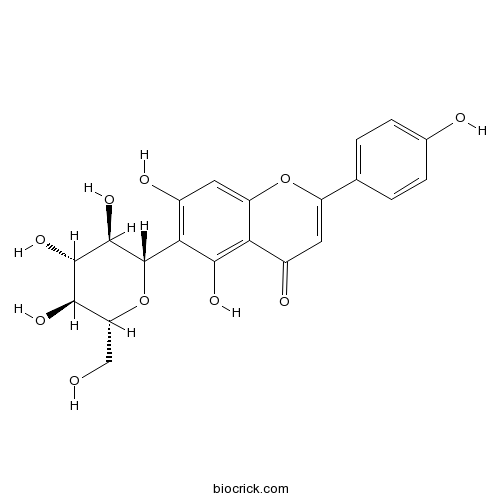Polygonatum odoratum
Polygonatum odoratum
1. The products in our compound library are selected from thousands of unique natural products; 2. It has the characteristics of diverse structure, diverse sources and wide coverage of activities; 3. Provide information on the activity of products from major journals, patents and research reports around the world, providing theoretical direction and research basis for further research and screening; 4. Free combination according to the type, source, target and disease of natural product; 5. The compound powder is placed in a covered tube and then discharged into a 10 x 10 cryostat; 6. Transport in ice pack or dry ice pack. Please store it at -20 °C as soon as possible after receiving the product, and use it as soon as possible after opening.
Natural products/compounds from Polygonatum odoratum
- Cat.No. Product Name CAS Number COA
-
BCN2643
Tannic acid1401-55-4
Instructions

-
BCN2280
Saponarin20310-89-8
Instructions

-
BCN5441
Isovitexin38953-85-4
Instructions

-
BCN5658
Apigenin520-36-5
Instructions

-
BCN4604
N-Feruloyloctopamine66648-44-0
Instructions

Homoisoflavonoids Are Potent Glucose Transporter 2 (GLUT2) Inhibitors: A Potential Mechanism for the Glucose-Lowering Properties of Polygonatum odoratum.[Pubmed: 29533635]
Foods of high carbohydrate content such as sucrose or starch increase postprandial blood glucose concentrations. The glucose absorption system in the intestine comprises two components: sodium-dependent glucose transporter-1 (SGLT1) and glucose transporter 2 (GLUT2). Here five sappanin-type (SAP) homoisoflavonoids were identified as novel potent GLUT2 inhibitors, with three of them isolated from the fibrous roots of Polygonatum odoratum (Mill.) Druce. SAP homoisolflavonoids had a stronger inhibitory effect on 25 mM glucose transport (41.6 ± 2.5, 50.5 ± 7.6, 47.5 ± 1.9, 42.6 ± 2.4, and 45.7 ± 4.1% for EA-1, EA-2, EA-3, MOA, and MOB) than flavonoids (19.3 ± 2.2, 11.5 ± 3.7, 16.4 ± 2.4, 5.3 ± 1.0, 3.7 ± 2.2, and 18.1 ± 2.4% for apigenin, luteolin, quercetin, naringenin, hesperetin, and genistein) and phloretin (28.1 ± 1.6%) at 15 μM. SAP homoisoflavonoids and SGLT1 inhibitors were found to synergistically inhibit the uptake of glucose using an in vitro model comprising Caco-2 cells. This observed new mechanism of the glucose-lowering action of P. odoratum suggests that SAP homoisoflavonoids and their combination with flavonoid monoglucosides show promise as naturally functional ingredients for inclusion in foods and drinks designed to control postprandial glucose levels.
Isolation, Structural Elucidation, and Liquid Chromatography-Mass Spectrometry Analysis of Steroidal Glycosides from Polygonatum odoratum.[Pubmed: 29262679]
None
Health Promotion Potential of Vegetables Cultivated in Northern Thailand: A Preliminary Screening of Tannin and Flavonoid Contents, 5α-Reductase Inhibition, Astringent Activity, and Antioxidant Activities.[Pubmed: 29228787]
Many of scientific evidences suggest that regular consumption of fruits and vegetables can prevent chronic diseases. In Northern Thailand, there are many vegetables that are usually consumed by local people. In this study, 17 local vegetables were selected and extracted with 95% ethanol. The extracts were screened for 5α-reductase inhibitory activity, total tannin and flavonoid contents, astringent and antioxidant activities. The results showed that Spondias pinnata and Ocimum americanum had the highest tannin and flavonoid content, respectively. Neptunia oleracea was the most potent 5α-reductase inhibitor. For antioxidant activities, S pinnata was the most potent ABTS (2,2'-azino-bis(3-ethylbenzothiazoline-6-sulfonic acid)) radical scavenger and the most potent ferric reducer. Polygonatum odoratum was the most potent hydrogen peroxide scavenger and Leucaena leucocephala was the most potent DPPH (2,2-diphenyl-1-picrylhydrazyl) radical scavenger among the tested samples. This suggests that local vegetables in Northern Thailand have a health promotion potential, which can be further developed as nutritional supplements, preventive medicines, and topical products for cosmetic purposes.
[Oligopeptides in plant medicines cited in Chinese Pharmacopoeia].[Pubmed: 28920330]
In total, 23 plant plant medicined containing oligopeptides were cited in Chinese Pharmacopoeia (1 part) of 2015 version including Rubia cordifolia, Linum usitatissimum, Aster tataricus, Psammosilene tunicoides, Pseudostellaria heterophylla, Stellaria dichotoma, Vaccaria segetalis, Dianthus superbus, Celosia argentea, Lycii Cortex, Citrus medica, C. aurantium, Panax ginseng, Parmx notoginseng, Schisandra chinensis, Sparganium stoloniferum, Euryale ferox, Ophiopogon japonicas, Pinellia ternate, Achyranthes bidentata, Physalis alkekengi, Polygonatum odoratum, and Leonuri Fructus. There were 187 oligopeptides in plant medicines above as reported. Oligopeptides consisted mainly of linear peptides and cyclic peptides. The linear peptides included dipeptides, tripeptides and pentapeptides, and cyclic peptides included cyclic, bicyclic and tricyclic peptides. The number of residues of single cyclic peptides ranged from two to twelve. Bicyclic peptides were isolated mainly from R. cordifolia and C. argentea. Modern pharmacological study showed that oligopeptides had many pharmacological effects, including antitumor, anticoagulant, antibacterial, immune suppression and so on.
Polygonatum odoratum lectin induces apoptosis and autophagy by regulation of microRNA-1290 and microRNA-15a-3p in human lung adenocarcinoma A549 cells.[Pubmed: 26562549]
Polygonatum odoratum lectin (POL), a mannose-binding specific Galanthus nivalis agglutinin (GNA)-related lectin has been reported with remarkable anti-proliferative and apoptosis-inducing effects against several tumor cells. Our previous research revealed that POL can induce apoptosis and autophagy in A549 cells. However, whether microRNAs (miRNAs) are involved in POL-induced apoptosis and autophagy in A549 cells has not been investigated. The aim of this study was to evaluate whether miRNAs were involved in POL-induced apoptosis and autophagy in A549 cells. In the present study, we performed microarray analysis on A549 cells to identify altered miRNAs after POL treatment. We found that miR-1290 was down-regulated after POL treatment and down-regulated miR-1290 amplifies POL-induced apoptosis in A549 cells. Moreover, we revealed that glycogen synthase kinase-3β (GSK3β) was a direct target of miR-1290 and POL treatment could result in Wnt pathway down regulation. We also found that miR-15a-3p was up-regulated after POL treatment and over-expression of miR-15a-3p resulted in A549 cells apoptosis and autophagy. In addition, we confirmed that a miR-15a-3p mediated ROS-p53 pathway was involved in POL-induced apoptosis and autophagy in A549 cells. Taken together, these data provide evidence that POL induces A549 cells apoptosis and autophagy by regulation of miR-1290 and miR-15a-3p.


